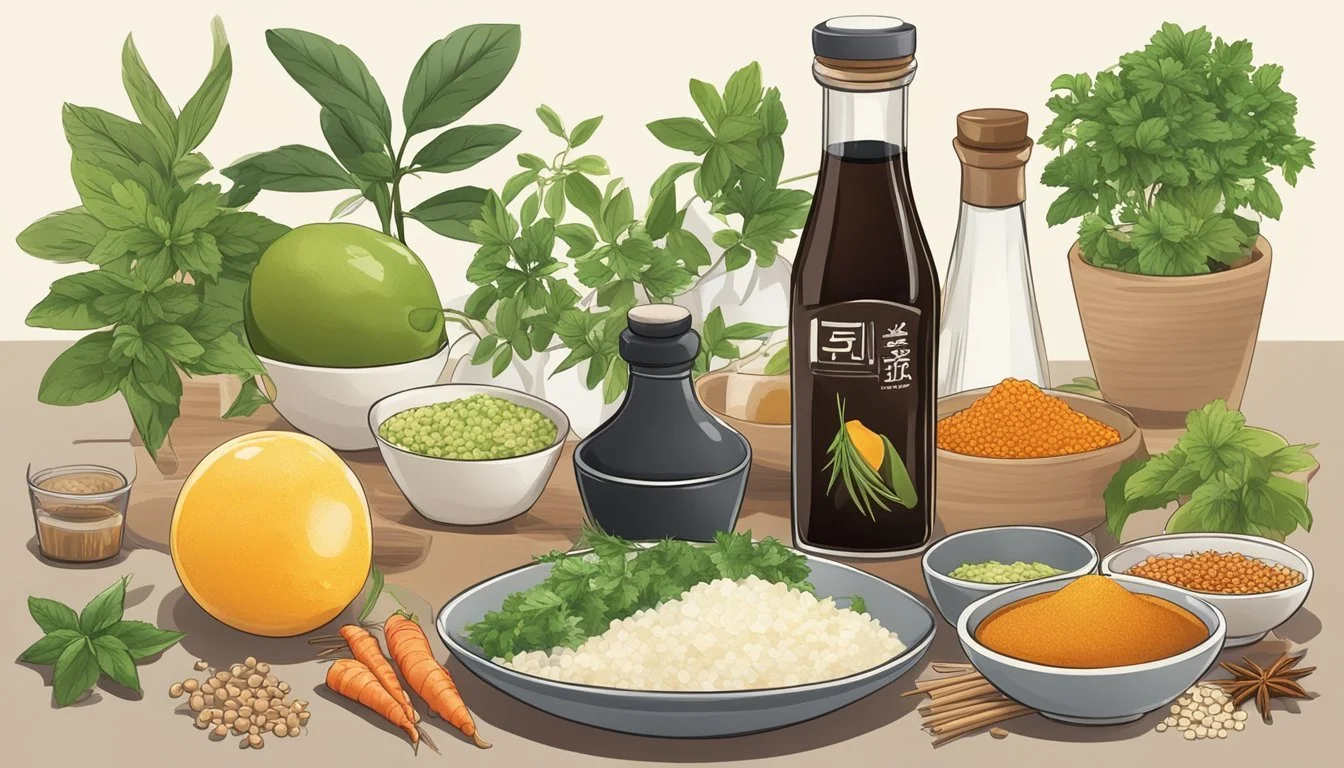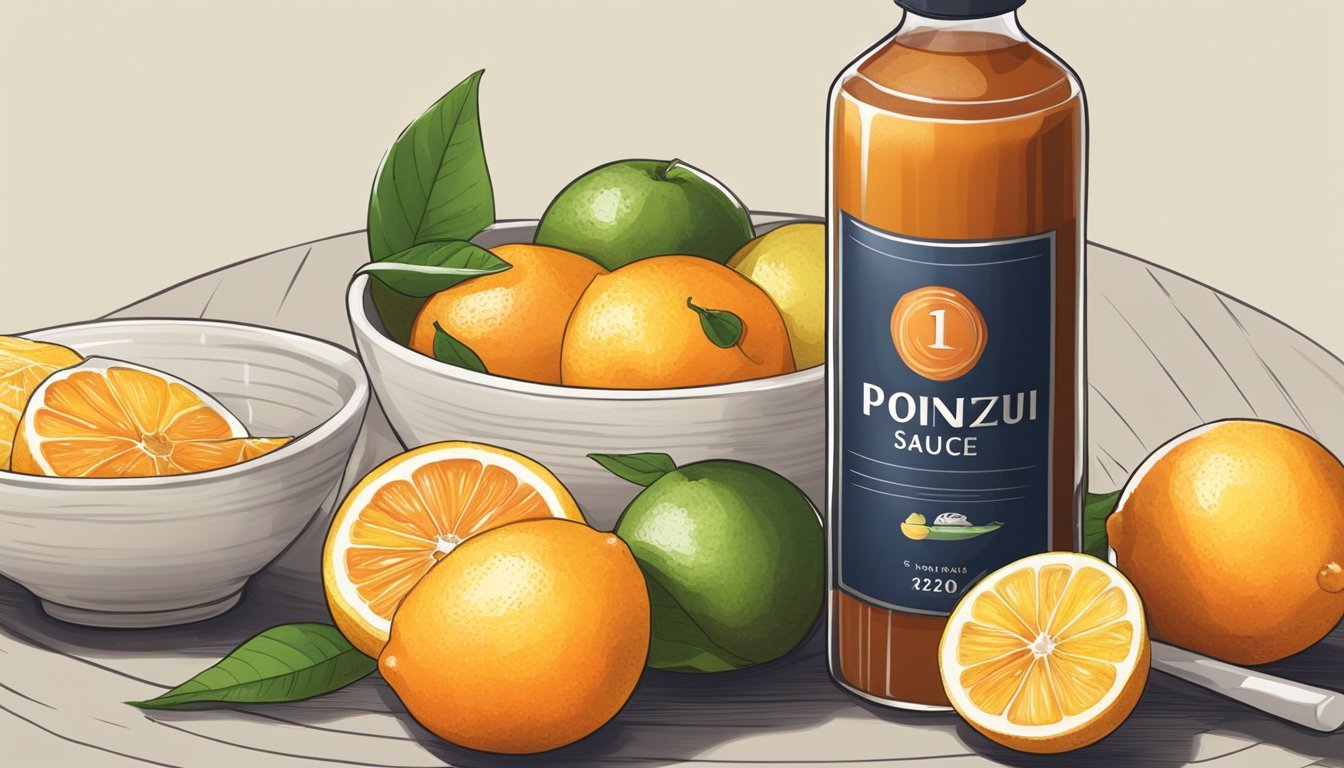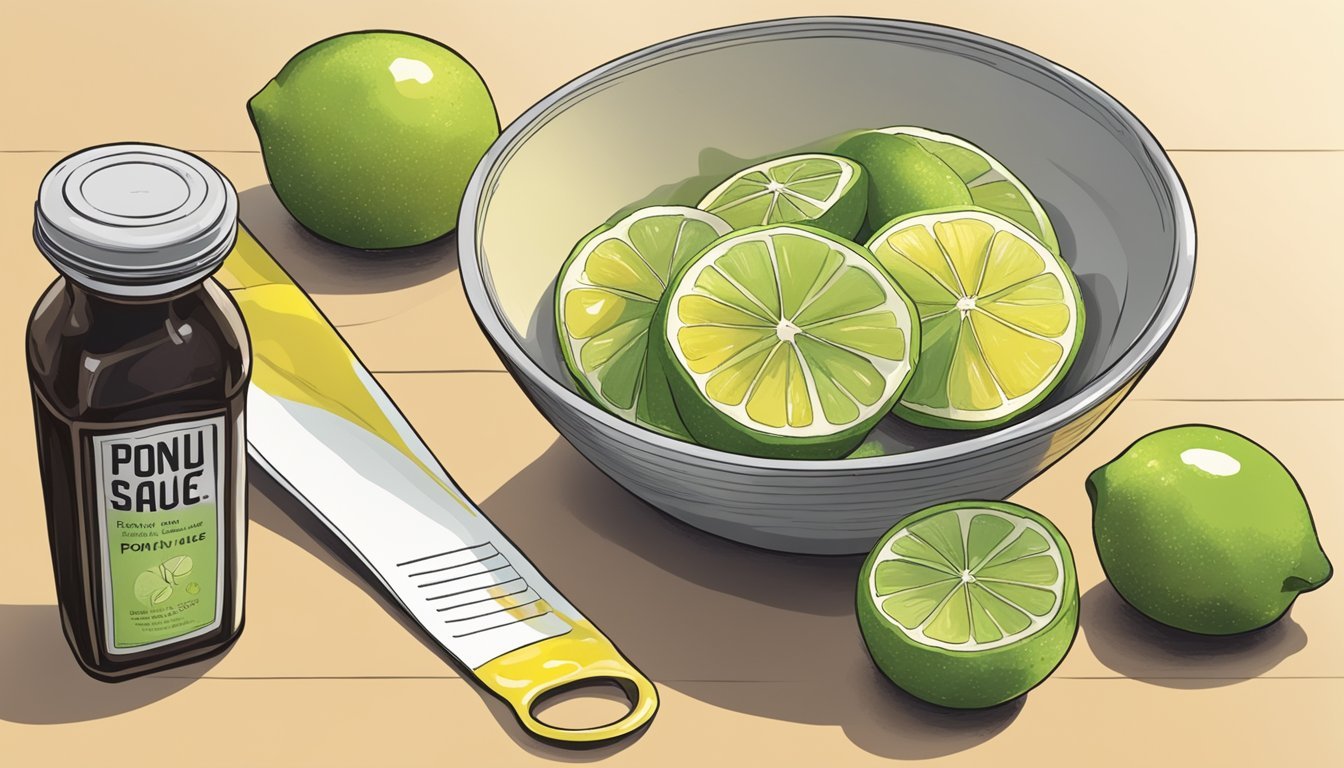How to Substitute Ponzu Sauce for Citrus Juice
A Simple Guide
Ponzu sauce is a staple in Japanese cuisine, known for its tangy, savory flavor with a citrus undertone. It commonly consists of soy sauce infused with citrus juice, and it's used in a variety of dishes from marinades to dressings. However, not everyone has access to store-bought ponzu sauce, and some may need to substitute it due to dietary restrictions or personal preferences.
When looking to replicate the unique taste of ponzu without the original ingredient, citrus juice emerges as a central component. It provides the necessary acidity and zest that characterizes ponzu. The key in using citrus juice as a substitute is to balance the sourness with the umami depth found in the traditional sauce, which can typically be achieved by incorporating additional ingredients commonly found in the kitchen.
Substituting ponzu sauce in cooking requires a careful blend of ingredients to match the expected flavor profile. While citrus juice provides the acidity, it lacks the soy sauce's savory component, which can be compensated for by adding soy sauce or tamari for a gluten-free option. This approach allows chefs and home cooks alike to create a comparable condiment that caters to the desired taste and maintains the integrity of the dishes they are used in.
Understanding Ponzu Sauce
To fully appreciate Ponzu sauce substitutes, it's essential to understand its history, unique flavor combination, and common ingredients. This sauce is a staple in Japanese cuisine, known for its ability to add a distinct umami and sour taste to dishes.
History and Origin
Ponzu sauce originates from Asia, with its roots deeply embedded in Japanese culinary traditions. It is believed to have been developed as a savory condiment to enhance the flavors of a variety of dishes. Over time, its use has spread widely beyond Asia, becoming a beloved ingredient in kitchens around the world for its unique taste.
Flavor Profile and Uses
Ponzu sauce is renowned for its complex flavor profile—a harmonious blend of savory umami and refreshing sourness. It typically combines soy sauce and citrus juice, often from yuzu, to create a versatile condiment. Ponzu sauce is used as a marinade, dressing, or dipping sauce, making it an integral component in many dishes within Japanese cuisine.
Marinade: Tenderizes proteins and infuses them with flavor.
Dressing: Adds a zesty twist to salads and vegetables.
Dipping Sauce: Complements the natural flavors of sushi, sashimi, and dumplings.
Common Ingredients in Ponzu
The distinctive taste of Ponzu sauce is a result of an intricate blend of ingredients:
Soy Sauce: Provides the base savory flavor.
Citrus Juice: Primary source of sourness, with yuzu being the preferred choice.
Vinegar: Enhances the tanginess and can be rice vinegar or mirin.
Sugar: Balances the sourness with a subtle sweetness.
Dashi: A broth made from seaweed (kombu) and dried bonito flakes (katsuobushi), contributes deeper umami notes.
These ingredients together create a condiment that accentuates a broad spectrum of flavors while maintaining a delicate balance between savory and tangy notes, making Ponzu sauce a unique and versatile element in Japanese cuisine.
Substituting Ponzu Sauce
When a recipe calls for ponzu sauce, which imparts a balance of tanginess, sweetness, and umami, home cooks might need alternative options if it is unavailable. Choosing the right substitute requires consideration of the dish's desired flavor profile and consistency.
When to Use Substitutes
Substitutes for ponzu can be used in nearly any recipe that requires the complex, citrus-inflected flavor of traditional ponzu sauce. The most common scenario is when ingredient availability is limited, and ponzu sauce isn't on hand. Home chefs might also seek alternatives to meet dietary requirements, such as a gluten-free option. For dishes that call for the bright acidity and subtle sweetness of ponzu, as well as its distinctive umami flavor, a blend of soy sauce and lemon juice can act as an efficient stand-in.
Factors to Consider
Flavor Profile: Ponzu sauce has a unique combination of acidity, sweetness, and umami. A mix of soy sauce and citrus juice, like lemon, can closely mimic this balance.
Acidity: To replicate ponzu's citrusy zest, fresh lemon juice is preferable. It is vital to adjust the acidity level depending on the strength of the citrus juice.
Umami Flavor: Soy sauce offers a deep umami aspect comparable to ponzu. When looking for a gluten-free option, tamari can serve the same purpose without the gluten found in traditional soy sauce.
Consistency: Ponzu has a thinner consistency than some of its substitutes. For thicker options like Worcestershire sauce, consider diluting with a bit of water.
Recipe Context: The chosen substitute should complement the other ingredients of the recipe without overpowering them.
In a recipe, the following table offers a quick reference on how to replace ponzu sauce and maintain the flavor integrity of the dish:
Substitute Ratio Notes Soy Sauce + Lemon Juice 1:1 May need diluting for lighter recipes. Tamari + Citrus Juice 1:1 For a gluten-free alternative that mimics ponzu's flavor. Adjust the type and amount of citrus based on acidity desired.
To achieve the most authentic flavor, using freshly squeezed citrus juice rather than bottled products are recommended, as they provide a more natural taste without synthetic overtones.
Citrus-Based Substitutes
When substituting Ponzu sauce, citrus juices provide the necessary acidity and tartness to mimic its distinct flavor profile. These juices are particularly effective in salad dressings and marinades where Ponzu is typically used.
Using Lemon Juice
Lemon juice offers a high level of acidity and a bright tartness, making it a classic substitution for Ponzu sauce. It works well in most recipes that require a citrusy kick. To substitute, they can mix soy sauce with lemon juice in equal parts. For a marinade or salad dressing, one might combine:
1 tablespoon soy sauce
1 tablespoon lemon juice
Optional: add a small amount of honey or sugar to balance the tartness
Lime Juice Alternatives
Lime juice, while similar to lemon, provides a unique tartness that can complement dishes requiring Ponzu sauce. Its distinct flavor is especially well-suited for dressings or dishes with a Latin or Southeast Asian flair. Substitution ratios remain the same as with lemon juice, and for best results, they can use:
1 tablespoon soy sauce
1 tablespoon lime juice
Optional: include additional flavors such as garlic or ginger to enhance the profile
Other Citrus Fruits
Beyond lemon and lime, other citrus juices like orange and grapefruit offer a sweeter substitute with a milder acidity. For a closer approximation to Ponzu's complexity, combining these juices with other ingredients can yield a satisfactory substitute:
Orange Juice: An excellent choice for baked dishes, with a zest of orange to reinforce the citrus note.
Grapefruit Juice: Works well when a bolder citrus flavor is needed, with its natural bitterness adding depth.
Yuzu Juice: For an authentic flavor closest to Ponzu, yuzu is ideal where available.
In each case, the citrus juice should be blended with soy sauce in a one-to-one ratio and adjusted to taste, ensuring the balance of sweetness and acidity complements the intended dish.
Non-Citrus Substitutes
For those looking to replicate the savory and tangy profile of Ponzu sauce without the use of citrus, there are viable non-citrus alternatives that focus on vinegar and soy sauce mixes. These substitutes can provide the tart flavor and umami depth that Ponzu is known for.
Vinegar-Based Alternatives
Flavor: Vinegar-based substitutes for Ponzu sauce cater to the sour taste aspect without introducing citrus flavors. The goal is to mimic the tanginess and brightness that Ponzu offers.
Rice Vinegar: A common choice, rice vinegar contributes a milder acidity and sweetness, aligning with Ponzu's distinct profile. To use, one might consider mixing:
1 part rice vinegar
1 part soy sauce or tamari (for a low-sodium option)
Apple Cider Vinegar: This type boasts a fruitier edge and can be an effective substitute when mixed with soy sauce to balance out the inherent sweetness.
Fruit Vinegar: Such as black vinegar, these can be used in Ponzu's stead, adding a depth of flavor with a more pronounced sourness.
Texture: These vinegars maintain a liquid consistency similar to Ponzu, ensuring the substitute integrates well in recipes that call for Ponzu sauce.
Soy Sauce Mixes
Flavor: Soy sauce mixtures are the backbone of Ponzu sauce, and by altering them with other components, one can emulate the umami without citrus.
Tamari: A gluten-free soy sauce alternative, tamari works well with a range of vinegars to produce a richer, less salty substitute for Ponzu.
Shoyu: Traditional soy sauce, or shoyu, is the base ingredient in many Ponzu recipes and can be paired with vinegar for the required acidity.
Low-Sodium Soy Sauce: Aids in reducing the overall salt content for those seeking a healthier option, all while preserving the essential savory notes.
Texture: Soy sauce mixtures tend to have a similar thinness to Ponzu sauce, making them an easy swap in terms of consistency. They blend seamlessly in marinades, dressings, and as a finishing sauce.
By carefully selecting the appropriate vinegar and soy sauce varieties, these non-citrus substitutes offer a way to achieve a Ponzu-like effect in dishes that require its unique blend of tangy, umami flavors.
Creative Substitutes
When looking to replicate the tangy, savory notes of Ponzu sauce, one can explore various substitutes from scratch or by combining unique ingredients. These alternatives aim to mimic the balance between the zesty citrus flavor and the depth of umami that Ponzu offers.
Homemade Ponzu Blends
To recreate the complexity of Ponzu, one may consider making a homemade blend that consists of:
Soy Sauce: Provides the salty, umami base.
Citrus Juice: Yuzu is traditional, but lemon or lime can work as substitutes.
Mirin: Adds a hint of sweetness and depth.
Rice Vinegar: Enhances the acidity and brightness.
Sugar: Balances the tanginess with sweetness.
One can mix these ingredients and adjust the quantities to match the desired flavor profile. Typically, the ratio would be one part citrus juice to one part soy sauce, with rice vinegar, mirin, and a pinch of sugar added to taste.
Unique Ingredient Mixes
For those seeking ready-to-use items from the pantry as Ponzu substitutes, consider these unique ingredient mixes:
Soy Sauce and Lemon Juice: The simplest swap, combining equal parts of each for an easy fix.
Worcestershire Sauce with a Splash of Lemon Juice: This mixture captures the tangy essence, with Worcestershire sauce imparting a complex flavor.
Other mixes that can resemble Ponzu's characteristics:
Tamarind paste diluted can mimic the sourness.
Nam Prik Pla (Thai fish sauce dressing) for a more pungent, umami-rich alternative.
Hoisin sauce, thinned with a bit of vinegar, can serve as a sweeter substitute.
Mentsuyu (Japanese noodle soup base) diluted with citrus juice could also suffice.
By understanding the core elements of Ponzu sauce, one can confidently experiment with these substitutes to achieve a comparable flavor in their cooking.
Considerations for Dietary Restrictions
When substituting Ponzu sauce, individuals with dietary restrictions need to be particularly attentive to ingredient lists. Precise substitutions can offer alternatives that cater to gluten-free diets or avoid certain allergens.
Gluten-Free Options
For those requiring a gluten-free diet, traditional soy sauce is not suitable due to its wheat content. An ideal substitute is tamari, a Japanese sauce similar to soy sauce but typically gluten-free. One can directly substitute tamari for soy sauce in equal parts when preparing a Ponzu-like citrus sauce.
Coconut aminos serve as another gluten-free alternative, offering a sweeter and less salty flavor profile. Though distinct from Ponzu, coconut aminos add a unique taste that complements citrus juices.
Substitute Characteristics Ratio Tamari Gluten-free, similar to soy sauce 1:1 Coconut Aminos Gluten-free, sweeter, less salty To taste
Avoiding Allergens
For individuals avoiding soy or fish-based allergens, other substitutions need consideration. Fish sauce or nam prik pla often has a similar umami quality but contains fish, making it unsuitable for those with fish allergies or vegetarians. In such cases, one might use mashed anchovies, (What wine goes well with anchovies?) which, although fish-based, can be included in small quantities to mimic Ponzu's flavor for those without fish allergies.
When avoiding soy, substitutions might be less conventional. Using additional citrus juice or zest can bring forward the desired tartness without introducing allergens. Careful label reading is essential to ensure that the chosen substitute fulfills dietary requirements and does not inadvertently contain allergens.
Substitute Allergen Use Case Anchovies Fish Small quantities, umami quality Citrus None Increased tartness, used in moderation
Utilizing Ponzu Substitutes in Recipes
When cooking without ponzu sauce, it's crucial to balance acidic tang and umami depth in your substitutes to achieve a similar flavor profile. Each culinary application, from marinating proteins to dressing vegetables, requires thoughtful selection of alternative ingredients.
Marinating Proteins
Marinating chicken or fish often relies on the complex flavors of ponzu. A substitute marinade can be made by whisking together equal parts soy sauce and citrus juice, such as lemon or lime, along with a dash of mirin for sweetness. If marinating delicate sashimi or tataki, one should ensure the acidity is not overpowering by adding the citrus component towards the end of the marination process.
Recipe Suggestion: Soy-Citrus Marinade
1/4 cup soy sauce
1/4 cup lemon juice
1 tablespoon mirin
Optional: Grated ginger for added zest
Dressing Vegetables and Salads
Creating a salad dressing or vinaigrette without ponzu calls for alternatives that can mimic its unique zest and umami. Mix soy sauce with a milder citrus like lime or orange juice, and a sweetener if desired, to toss with salads or lightly drizzle over steamed vegetables.
Bold Flavors for Vegetables:
Combine 1 part soy sauce with 2 parts orange juice
Sweeten with a teaspoon of honey
Adjust with a splash of rice vinegar for more tang
Enhancing Stir-Fries and Dumplings
Ponzu brings life to stir-fries and is a common dipping sauce for dumplings. In its absence, integrate soy sauce, a squeeze of fresh citrus juice, and a hint of sweetness to replicate the dynamic flavor. Introduce this mixture towards the end of cooking to maintain the integrity of the citrus notes.
Stir Fry & Dumpling Sauce:
3 tablespoons soy sauce
1 tablespoon lemon juice
1 teaspoon sugar or mirin
Optional: Minced garlic or chili for heat
By using these substituted mixtures, cooks can closely emulate the intended effects of ponzu in their recipes, ensuring that the intended flavors are well represented.
Storing and Preserving Substitutes
Proper storage of ponzu sauce substitutes is crucial for maintaining their flavor and longevity. Adhering to appropriate refrigeration guidelines and understanding the shelf life of various ingredients ensures that your substitute remains fresh and ready to use.
Refrigeration Tips
After preparing a ponzu sauce substitute, such as a mixture of soy sauce and lemon juice, it is essential to store it in the refrigerator. The cool environment helps preserve the freshness of the citrus juice and maintains the consistency of the sauce. To store liquid substitutes, one should always use a clean glass jar with a tight-fitting lid. For solid ingredients like sugar or vinegar, they should be kept in their original packaging if it's resealable, or transferred to airtight containers to prevent clumping or moisture absorption.
Strain any solids, like bonito flakes, from the mixture before storing to avoid an increase in saltiness or changes in texture. When refrigerating, label the container with the date of preparation.
Containers: Airtight, clean, non-reactive (glass or plastic)
Temperature: Consistently below 40°F (4°C)
Location: Store in the coldest part of the refrigerator
Shelf Life Considerations
The shelf life of homemade ponzu substitutes largely depends on the ingredients and their individual expiration dates. Acidic components, such as citrus juice, and high salt content can help preserve the mixture for a limited time. However, to ensure optimal freshness, one should aim to consume the substitute within three days.
Citrus-based substitutes: 3-5 days
Vinegar-based substitutes: 1-2 weeks, due to vinegar's natural preservative properties
Sugar and salt mixtures: Varies, often several weeks if kept dry and uncontaminated
For longer storage, some substitutes may be suitable for freezing, although this can alter consistency. If freezing is necessary, pour the substitute into an ice cube tray, allowing for easy thawing of small usable portions later on. Always remember that freezing might not be suitable for all substitutes, especially those containing ingredients that separate when frozen and thawed.










